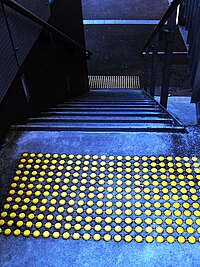
Photo from wikipedia
Touch is perceived most pleasant when delivered at velocities known to optimally activate the C-Tactile afferent system. At the group level, pleasantness ratings of touch delivered at velocities in the… Click to show full abstract
Touch is perceived most pleasant when delivered at velocities known to optimally activate the C-Tactile afferent system. At the group level, pleasantness ratings of touch delivered at velocities in the range between 0.3 and 30 cm/s follows an inverted-U shape curve, with maximum pleasantness between 1 and 10 cm/s. However, the prevalence, reliability, and stability of this function at the individual level and across skin types based on hair density remains unknown. Here, we tested a range of seven velocities (0.3, 1, 3, 6, 9, 18, 27 cm/s) delivered with a soft brush, on both hairy (forearm and dorsal hand) and non-hairy skin (palm) in 123 participants. Our results suggest that the relationship between pleasantness and velocity of touch is significantly best described by a negative quadratic model at the individual level in the majority of participants both on hairy (67.1%) and non-hairy (62.6%) skin, a larger extent than previously reported. Higher interoceptive accuracy and self-reported depression were related to a better fit of the quadratic model and to the steepness of the curve, respectively. The prevalence of the quadratic model at the individual level was stable across body sites (62.6%, Experiment 1), across two experimental sessions (73-78%, Experiment 2), and regardless of the number of repetitions of each velocity (Experiment 3). Thus, the individual perception of tactile pleasantness follows a characteristic velocity-dependent function across skin types and shows trait characteristics. Future studies can investigate further the possibility to use affective touch as a behavioural biomarker for mental health disorders.
Journal Title: Journal of neurophysiology
Year Published: 2022
Link to full text (if available)
Share on Social Media: Sign Up to like & get
recommendations!